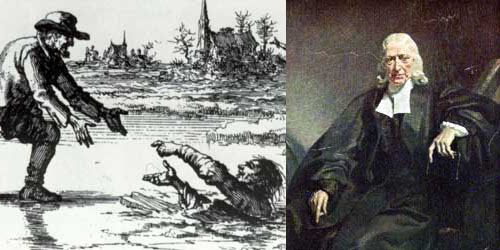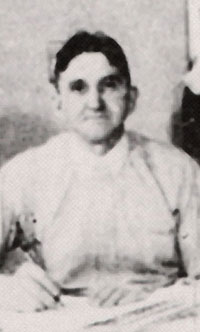
As movements that generally rejected intellectualized expressions of faith and embraced ethical orthopraxy, both Anabaptism and Wesleyan holiness emphasized the renunciation of sinful behavior and a full turn toward obedience to Christ: in other words, nonconformity to what the Brethren in Christ termed “the world.”
For scholars of Brethren in Christ life and thought, suggesting utter congruence between these two ethical frameworks might be tempting. After all, both emphasize conversion, consecration, and separation as methods for living a life pleasing to God. Yet as an article in a 1934 edition of the Evangelical Visitor indicates, turn-of-the-century Brethren in Christ conceived of dramatically different — though related — reasons why the Anabaptists and the holiness people rejected “the world.”
A distinction between Anabaptist and holiness conceptions of “the world,” after the jump.

In an editorial appropriately titled “‘The World,'” Visitor editor V.L. Stump — an outspoken advocate of second-work holiness doctrine among the Brethren in Christ — describes the then-and-now differences between the classic Anabaptist and Wesleyan holiness views in regards to nonconformity and distinctiveness:
So long as the world was visibly heathen, was antagonistic to the church of Christ, and constantly warred against it with bitter and relentless persecution, there was no common ground upon which the world and the church could meet. It was only when the individual in the world renounced his heathenism and accepted Christ in all His fullness that he was transplanted from the kingdom of darkness into the kingdom of God’s dear Son.
To-day it is not quite thus for the world is now inside the fold, baptized, catechized, and is worshipping in a cold formalistic self-worship which is far more dangerous than the outward visible antagonism of the heathen world ever was. [1]
The first paragraph outlines (in very broad strokes) the Anabaptist concept: the world and the church in contradistinction to one another — a black-and-white, near-Manichean understanding. [2] The Anabaptists were concerned about society — about its vanity, its corruption, its opposition to love, charity, and true conversion. This society held values diametrically opposed to those values held by the true church; between such groups, as Stump declares, there could be no congruence. Thus, Anabaptists separated themselves from the rest of society, establishing an alternate community and culture that sought to model the Kingdom of Heaven.
The holiness movement, by contrast, were concerned about human nature — a natural inclination toward sinfulness, bred into every human heart by virtue of The Fall. Holiness people therefore challenged “the old man” — a euphemistic descriptor of human sinfulness — and viewed it as at odds to God’s call for purity of mind and spirit. Thus, as Stump details, holiness leaders called their adherents to “be like [God] in all things,” a veiled allusion to what was then doctrinally controversial among the Brethren in Christ: the experience of sanctification as a distinct second work of grace. This call meant that Christians should eschew any activity, obligation, or pursuit that might lead them away from God’s perfection — including “heart” conditions like gossip, slander, and pride, as well as societal trends like dancing, motion pictures, and alcohol.
Stump’s final line boils down the distinction into a helpful phrase:
Our safety is not so much in where we are as in what we are.
In Stump’s estimation, the Anabaptists rejected “the world” through separation — a locational configuration which involved physically removing and isolating themselves from that which runs counter to God. On the other hand, the holiness people rejected “the world” through purification — a transformational configuration that involved changed hearts and minds, resulting in changed people (who no longer wanted to be around corrosive influences). As one sanctified Brethren in Christ once wrote,
The baptism of fire will burn out of our hearts selfishness and hatred. It burns out the desire to look like the world, gives a real hatred for it. [3]
Though not wholly congruent, these two visions of “the world” were complimentary in many Brethren in Christ hearts and minds: taken together, they comprised a more holistic understanding of how to remain pure and holy in the midst of a condition — both external and internal — antagonistic toward such godly living.
Read Stump’s full article here.
Notes
[1] Vernon L. Stump, “‘The World'” (editorial), Evangelical Visitor, May 21, 1934, 163 (3).
[2] This description of the Anabaptist understanding of nonconformity as “black-and-white” is reflected in E. Morris Sider, “Living on the sidelines in the 21st century,” in Linda Brandi Cateura, Protestant Portraits: People of Many Cultures Bring New Challenges and Startling Lifestyles to an Old Religion (iUniverse, 2002), 132: “Historically, the concept of separation was expressed in rather black-and-white terms. There are two kingdoms — the kingdom of this world, ruled by Satan, and the kingdom of God. For the Anabaptists, separation meant that as a Christian, you had to make a decision: What world are you going to live in?”
[3] Adda G. Wolgemuth, “The Baptism of the Holy Ghost and Fire,” Evangelical Visitor, December 1, 1930, 22, qtd. in Carlton Wittlinger, Quest for Piety and Obedience (Nappanee, Ind.: Evangel Press, 1978), 350.
